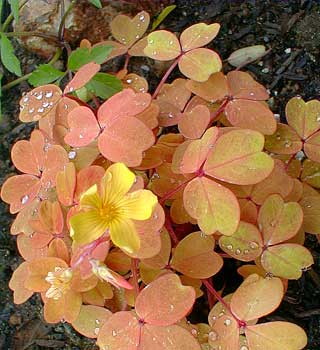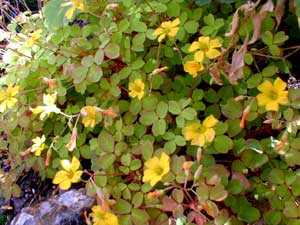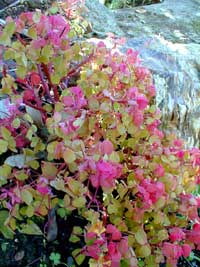
Sunset
Velvet
Shamrock
"Ah! the tramp of feet victorious! I should hear them
'Mid the shamrocks & the mosses,
And my heart should toss within the shroud & quiver
As a captive dreamer tosses."
-Fanny Parnell
(1848-1882)
(1848-1882)
'Sunset Velvet' is a brighter cultivar of Copper Velvet Shamrock (Oxalis siliquosa, formerly O. vulcanicola), possibly the most beautiful of all oxalis species & varieties, shown in this April morning photo with dew on its leaves.
The wild form has only a coppery sheen, but 'Sunset Velvet' brings the oranges & golds into fantastic dominance.
It has the brightest coral-red stems, covered over with leaves that are gold, orange, pink, & coppery yellow. By late July through early September, the color softens toward lime green, as shown in the second photo snapped in August.
 In the cool weather of spring & mid-Autumn, into the 40s Fahrenheit & surviving light morning frosts in the fall, it remains one of the great stand-outs for remarkable foliage.
In the cool weather of spring & mid-Autumn, into the 40s Fahrenheit & surviving light morning frosts in the fall, it remains one of the great stand-outs for remarkable foliage.Its colors are most startling in spring's fresh golds & oranges, & again in autumn when leaves turn deep magenta, as shown in the third photo snapped in November. See the 'Sunset Velvet' Oxalis Page of the Autumn Leaves Gallery for additional pics of its appearance in Autumn.
Its bright yellow flowers could almost have been redundant to the flowery brightness of the leaves, but are themselves such a pure intense color, they are not at risk of seeming pallid against such brilliant leaves. As it reblooms in summer, the yellow against lime-green leaves is very pleasing. A few random flowers will appear in autumn, too.
 Mostly upright but with a touch of trailing behavior, it rarely reaches up higher than six or eight inches, but spreads by creeping over the surface of the ground. Unlike many other oxalis species, it does not have tubers. The red stems are rather thick for which reason it is known in Scandinavia as "Succulent Clover."
Mostly upright but with a touch of trailing behavior, it rarely reaches up higher than six or eight inches, but spreads by creeping over the surface of the ground. Unlike many other oxalis species, it does not have tubers. The red stems are rather thick for which reason it is known in Scandinavia as "Succulent Clover."It is by no means invasive, so anyone alarmed by the threat of "Omigod, Oxalis!" need not worry about this one. As a tender perennial, it is sometimes treated mainly as a seasonal container plant, a virtual annual since it does not reliably survive winters.
In 2003 we had a cold-snap in late November that lasted a week, & the continuously beautiful carpet of leaves finally shrivelled & died back. Curiously its final yellow flowers were unharmed by the frost, still bright over the shrivelling leaves.
It did not return in spring, but it's not unheard of that it does last a few years in our temperate zone. Often in zone 8 it has been known to keep a small percentage of its leaves through much of winter then bounce back in spring, being semi-hardy in a protected shady location.